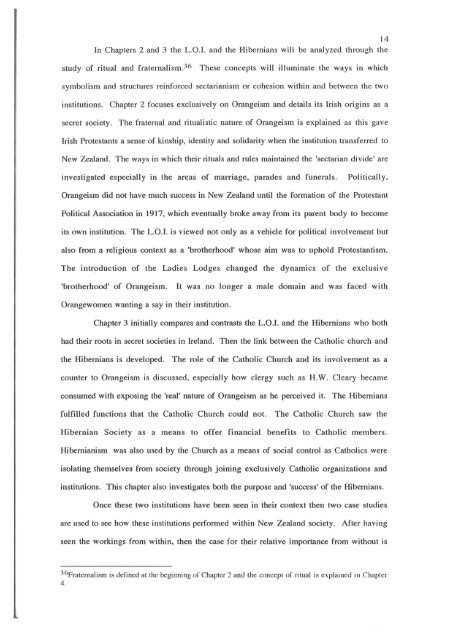TRANSPLANTED IRISH INSTITUTIONS - University of Canterbury
TRANSPLANTED IRISH INSTITUTIONS - University of Canterbury
TRANSPLANTED IRISH INSTITUTIONS - University of Canterbury
You also want an ePaper? Increase the reach of your titles
YUMPU automatically turns print PDFs into web optimized ePapers that Google loves.
14<br />
In Chapters 2 and 3 the L.O.I. and the Hibernians will be analyzed through the<br />
study <strong>of</strong> ritual and fraternalism. 36<br />
These concepts will illuminate the ways in which<br />
symbolism and structures reinforced sectarianism or cohesion within and between the two<br />
institutions. Chapter 2 focuses exclusively on Orangeism and details its Irish origins as a<br />
secret society. The fraternal and ritualistic nature <strong>of</strong> Orangeism is explained as this gave<br />
Irish Protestants a sense <strong>of</strong> kinship, identity and solidarity when the institution transferred to<br />
New Zealand. The ways in which their rituals and rules maintained the 'sectarian divide' are<br />
investigated especially in the areas <strong>of</strong> marriage, parades and funerals.<br />
Politically,<br />
Orangeism did not have much success in New Zealand until the formation <strong>of</strong> the Protestant<br />
Political Association in 1917, which eventually broke away from its parent body to become<br />
its own institution. The L.O.I. is viewed not only as a vehicle for political involvement but<br />
also from a religious context as a 'brotherhood' whose aim was to uphold Protestantism.<br />
The introduction <strong>of</strong> the Ladies Lodges changed the dynamics <strong>of</strong> the exclusive<br />
'brotherhood' <strong>of</strong> Orangeism.<br />
It was no longer a male domain and was faced with<br />
Orangewomen wanting a say in their institution.<br />
Chapter 3 initially compares and contrasts the L.O.1. and the Hibernians who both<br />
had their roots in secret societies in Ireland. Then the link between the Catholic church and.<br />
the Hibernians is developed. The role <strong>of</strong> the Catholic Church and its involvement as a<br />
counter to Orangeism is discussed, especially how clergy such as H.W. Cleary became<br />
consumed with exposing the 'real' nature <strong>of</strong> Orangeism as he perceived it. The Hibernians<br />
fulfilled functions that the Catholic Church could not.<br />
The Catholic Church saw the<br />
Hibernian Society as a means to <strong>of</strong>fer financial benefits to Catholic members.<br />
Hibernianism was also used by the Church as a means <strong>of</strong> social control as Catholics were<br />
isolating themselves from society through joining exclusively Catholic organizations and<br />
institutions. This chapter also investigates both the purpose and 'success' <strong>of</strong> the Hibernians.<br />
Once these two institutions have been seen in their context then two case studies<br />
are used to see how these institutions performed within New Zealand society. After having<br />
seen the workings from within, then the case for their relative importance from without is<br />
36Fratemalism is defined at the beginning <strong>of</strong> Chapter 2 and the concept <strong>of</strong> ritual is explained in Chapter<br />
4.
















